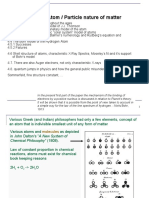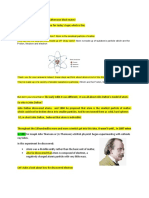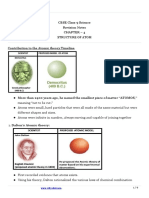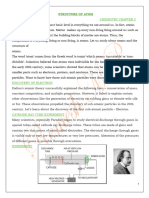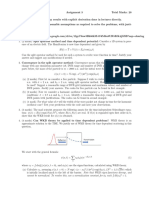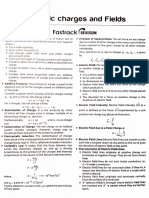Chapter 27 Models of The Atom
Chapter 27 Models of The Atom
Uploaded by
Alicia WilliamsCopyright:
Available Formats
Chapter 27 Models of The Atom
Chapter 27 Models of The Atom
Uploaded by
Alicia WilliamsOriginal Title
Copyright
Available Formats
Share this document
Did you find this document useful?
Is this content inappropriate?
Copyright:
Available Formats
Chapter 27 Models of The Atom
Chapter 27 Models of The Atom
Uploaded by
Alicia WilliamsCopyright:
Available Formats
models of the
27
Chapter
Atom
Demokritos, the Greek philosopher, suggested about 2 500 years
ago that all things were made of tiny indivisible particles. In Greek,
the word atomos (from which the word atom is derived from)
means ‘cannot be cut’ or ‘indivisible’.
In Physics, it is understood that the meaning no longer holds true.
Thanks to science, we know that atoms are made of sub-atomic
particles called neutrons, protons and electrons.
The number of these particles determines the properties of each
element.
Chapter 27: Models of the Atom
Discovery of the Electron
In a cathode ray tube, electrodes (positive and negative) are placed at the ends of the
tube. When a high voltage is applied across the electrodes, a pale green glow
appears at the anode end of the tube.
The green glow was discovered to be caused by invisible radiation coming from the
cathode. The cathode rays collide with the glass near anode causing the green glow.
Chapter 27: Models of the Atom
When a thin beam of cathode ray was passed in between oppositely charged
plates, the beam deflected towards the positively-charged plate. This indicates
that the cathode ray is negatively-charged.
Chapter 27: Models of the Atom
J.J. Thomson adapted the cathode ray tube
to measure the deflection of the cathode
rays due to an electric field and a magnetic
field.
He was able to deduce experimentally that
the cathode rays behave like tiny, fast
moving particles (same charge to mass
ratio).
In 1897, he confirmed the existence of the
tiny, negatively-charged particles.
They were named electrons.
Chapter 27: Models of the Atom
1904: Thomson’s Plum Pudding Model
The atom is viewed as negatively-
charged electrons swimming in a
positively-charged matter.
1911, 1919: Rutherford’s Model
Rutherford’s model states that the
atom consists of electrons travelling
around a nucleus. The nucleus is a
highly concentrated positively-
charged volume of matter that is very
much smaller than the rest of the
atom.
Chapter 27: Models of the Atom
1932: Discovery of the Neutron
Chadwick discovered particles in the nucleus of the atom (neutron) that have no
charge.
Chadwick had been bombarding beryllium targets with alpha particles. The released
penetrating rays were unaffected by electric and magnetic fields. This meant that
the rays do not carry a charge.
Further tests showed that the radiation was able to knock out protons from blocks of
paraffin.
Chadwick was able to conclude that
these particles carried no charge and
were of similar size to protons.
These particles were named neutrons
and they exist in the nucleus of all atoms.
Chapter 27: Models of the Atom
1913: Bohr’s Model
In Bohr’s Model, the electrons travel around a very small positively-charged nucleus
in ‘shells’ of specific diameters.
According to Bohr, the electrons are allowed to travel only within these specific
shells. Each orbit is associated with a particular energy level.
Chapter 27: Models of the Atom
Chapter 27: Models of the Atom
In 1909, Geiger and Marsden bombarded a thin gold foil with alpha particles.
They are detected when they hit
the zinc sulphide screen which
fluoresces upon collision.
The alpha particles were small and fast There were small sparks of light
enough to penetrate through the thin foil. during the collision
(scintillations).
Chapter 27: Models of the Atom
Geiger and Marsden measured the angle of deflections of the alpha particles
by observing the scintillations.
Expected results Observed results
By analysing the results of their experiment,
Rutherford was able to make the following conclusions:
1) Most of the alpha particles passed through without
deflecting the atom is mainly empty space.
2) A small number of alpha particles were deflected and
atoms are understood to have mass the atom must have a
very small compact nucleus and the nucleus is positively-charged.
Chapter 27: Models of the Atom
You might also like
- Workbook 2Document6 pagesWorkbook 2elianys1No ratings yet
- Atomic Structure PDFDocument49 pagesAtomic Structure PDFAshishNo ratings yet
- Lesson 4Document3 pagesLesson 4Ariane Fatima NalupaNo ratings yet
- Physics Chapter 22Document26 pagesPhysics Chapter 22kk.sheela243No ratings yet
- Chemistry Chapter OneDocument16 pagesChemistry Chapter Onedemro channelNo ratings yet
- Structure of An Atom and The Periodic TableDocument2 pagesStructure of An Atom and The Periodic TableErika Dela CruzNo ratings yet
- Atomic Structure VMC Study MaterialDocument52 pagesAtomic Structure VMC Study MaterialMameNo ratings yet
- 4Document812 pages4Anand VishwakarmaNo ratings yet
- Vidya Mandir Classes Class 11 ChemDocument812 pagesVidya Mandir Classes Class 11 ChemAtharvvaNo ratings yet
- Atomic Models Class 11Document33 pagesAtomic Models Class 11Maira XDNo ratings yet
- Class 11 Chemistry Ch-2 Notes (1)Document7 pagesClass 11 Chemistry Ch-2 Notes (1)anuj123kumar123mnrNo ratings yet
- 13 Atomic Theory Development 2Document30 pages13 Atomic Theory Development 2Anonymous j3od2GnAgzNo ratings yet
- Atomic StructureDocument110 pagesAtomic StructuresnsfaojiaNo ratings yet
- Structure of The Atom / Particle Nature of MatterDocument49 pagesStructure of The Atom / Particle Nature of Matterleizl MoncadaNo ratings yet
- Atomic Stru Best NotesDocument36 pagesAtomic Stru Best Notesiampriyatiwarii890No ratings yet
- Chemistry 9_Part2Document28 pagesChemistry 9_Part2ShaistaNo ratings yet
- History of The Atom 1. J.J Thomson'S Experiment To Detect The ElectronDocument4 pagesHistory of The Atom 1. J.J Thomson'S Experiment To Detect The ElectronYeni SurantiNo ratings yet
- Atomic Structure Full Notes 50 PageDocument52 pagesAtomic Structure Full Notes 50 PageSubhajit GoraiNo ratings yet
- CHM1 11 - 12 Q1 0403 PF FDDocument48 pagesCHM1 11 - 12 Q1 0403 PF FDTacooNo ratings yet
- The History of The AtomDocument25 pagesThe History of The AtomTrevor KobeNo ratings yet
- The Structure of The AtomDocument6 pagesThe Structure of The AtomJoon Bok NamleeNo ratings yet
- Unit 2. The AtomDocument26 pagesUnit 2. The Atomgarciaortegajulia5No ratings yet
- CBSE Class 9 Science Revision Notes Chapter - 4 Structure of AtomDocument7 pagesCBSE Class 9 Science Revision Notes Chapter - 4 Structure of AtomShweta ShuklaNo ratings yet
- First Year Chemistry 20-02Document100 pagesFirst Year Chemistry 20-02Ahmed Hassan Mina HamadNo ratings yet
- CHM 101-Topic 1Document28 pagesCHM 101-Topic 1georgegalea78No ratings yet
- Genchem1-Week2 ModuleDocument10 pagesGenchem1-Week2 Moduleian babiloniaNo ratings yet
- Atomic StructureDocument70 pagesAtomic Structuresuramameherchem27No ratings yet
- Structure of Atom-TypedDocument25 pagesStructure of Atom-Typediringrace7No ratings yet
- Atomic Theory and ModelsDocument42 pagesAtomic Theory and ModelsJesiah PascualNo ratings yet
- Atoms: Chapter TwelveDocument16 pagesAtoms: Chapter TwelveBhoomika VijayakumarNo ratings yet
- History of Atomic TheoryDocument38 pagesHistory of Atomic TheorylovelyshaneibrahimNo ratings yet
- Structure of Atoms: Chapter-9 1Document9 pagesStructure of Atoms: Chapter-9 1Willis ChekovNo ratings yet
- Models of Atoms: The Thomson ModelDocument6 pagesModels of Atoms: The Thomson ModelIacob Ventum LeonardusNo ratings yet
- Atomic Structure: Md. Kaium HossainDocument25 pagesAtomic Structure: Md. Kaium Hossainmahikazad91No ratings yet
- Xi Chem CH 2Document16 pagesXi Chem CH 2ALOK MISHRANo ratings yet
- Atomic Timeline: Date Scientist Discovery/TheoryDocument2 pagesAtomic Timeline: Date Scientist Discovery/TheoryBong PilotinNo ratings yet
- Models of The Atom: David SangDocument4 pagesModels of The Atom: David SangMaine MedilloNo ratings yet
- G 9 CH 3.2 Models of Atoms HighlightsDocument21 pagesG 9 CH 3.2 Models of Atoms HighlightsAya SoufiNo ratings yet
- Atomic Structure ModelsDocument3 pagesAtomic Structure Modelsom.kumarNo ratings yet
- CH 1Document58 pagesCH 1smohammedadenNo ratings yet
- Structure of AtomDocument10 pagesStructure of Atomالمونتاج الاخيرNo ratings yet
- Subatomic Particles Models of An AtomDocument36 pagesSubatomic Particles Models of An AtomrayNo ratings yet
- Atomic Models: Yasmin Gervacio, Fausto Liz, Libby Martinez and Alicia RosarioDocument22 pagesAtomic Models: Yasmin Gervacio, Fausto Liz, Libby Martinez and Alicia Rosariolibby martinezNo ratings yet
- Atomic PhysicsDocument5 pagesAtomic Physicslove meNo ratings yet
- TRM 3Document79 pagesTRM 3chilekwamichael26No ratings yet
- Atomic Structure NotesDocument4 pagesAtomic Structure Notesrielanlamba13No ratings yet
- Ch-2 Chemistry (Structure of Atom) Class-11Document10 pagesCh-2 Chemistry (Structure of Atom) Class-11kartikaryan9250No ratings yet
- Points To Remember Class: XI CH 2: Structure O AtomDocument15 pagesPoints To Remember Class: XI CH 2: Structure O Atomaustinfru7No ratings yet
- Block 5: Atomic Physics: #Thenuclearatom #RadioactivityDocument70 pagesBlock 5: Atomic Physics: #Thenuclearatom #RadioactivityMac Justine JimenezNo ratings yet
- Structure of AtomDocument106 pagesStructure of AtomJayesh ChouhanNo ratings yet
- Evolution of Atomic StructureDocument17 pagesEvolution of Atomic StructurePIO DASNo ratings yet
- ContentDocument17 pagesContentpalanir284100% (1)
- TRM 4Document51 pagesTRM 4AnaNo ratings yet
- Atomic Structure - Development and ConclusionsDocument3 pagesAtomic Structure - Development and ConclusionsJack HuynhNo ratings yet
- Chemistry Reading Material Part 1Document21 pagesChemistry Reading Material Part 1RashpreetNo ratings yet
- AtomosDocument76 pagesAtomosJenny BrendonNo ratings yet
- Chemistry For FreshmenDocument9 pagesChemistry For FreshmenMeo Angelo AlcantaraNo ratings yet
- Reviewer in Chem 1Document2 pagesReviewer in Chem 1MARY ZIANNE GABRIELLE QUINTONo ratings yet
- Chapter 01 Fundamental and Derived QuantitiesDocument7 pagesChapter 01 Fundamental and Derived QuantitiesAlicia WilliamsNo ratings yet
- Chapter 06 Linear MotionDocument12 pagesChapter 06 Linear MotionAlicia WilliamsNo ratings yet
- Chapter 04 VectorsDocument9 pagesChapter 04 VectorsAlicia WilliamsNo ratings yet
- Chapter 29 RadioactivityDocument21 pagesChapter 29 RadioactivityAlicia WilliamsNo ratings yet
- Chapter 24 ElectronicsDocument13 pagesChapter 24 ElectronicsAlicia WilliamsNo ratings yet
- Chapter 14 Reflection and Refraction of LightDocument37 pagesChapter 14 Reflection and Refraction of LightAlicia WilliamsNo ratings yet
- Chapter 19 Electromagnetic WavesDocument16 pagesChapter 19 Electromagnetic WavesAlicia WilliamsNo ratings yet
- Chapter 21 Current ElectricityDocument13 pagesChapter 21 Current ElectricityAlicia WilliamsNo ratings yet
- Chapter 15 LensesDocument18 pagesChapter 15 LensesAlicia WilliamsNo ratings yet
- Chapter 13 Gas LawsDocument14 pagesChapter 13 Gas LawsAlicia WilliamsNo ratings yet
- Handbook of Thin Plate Buckling and PostbucklingDocument776 pagesHandbook of Thin Plate Buckling and PostbucklingReivax50100% (3)
- Arpa Related TermsDocument2 pagesArpa Related TermsPrince100% (1)
- Projectile Motion EDEXCELDocument16 pagesProjectile Motion EDEXCELThoon Nadi NaiNo ratings yet
- MecanicaaaaDocument2 pagesMecanicaaaaVener AndreiNo ratings yet
- Balachandran, KanagaratnamDocument162 pagesBalachandran, KanagaratnamSafwat El RoubyNo ratings yet
- CH 3 - Problems 2023-12-27 22 - 14 - 56Document2 pagesCH 3 - Problems 2023-12-27 22 - 14 - 56rb8q9sz8hrNo ratings yet
- PS Q2 Week-3a-1Document8 pagesPS Q2 Week-3a-1Faith PacomiosNo ratings yet
- Bche 111L - Chemistry For Engineers Week 1-5 (Sim-Sdl)Document122 pagesBche 111L - Chemistry For Engineers Week 1-5 (Sim-Sdl)Mc Orland Kyle TuazonNo ratings yet
- Solutions PDFDocument7 pagesSolutions PDFChami LiyanageNo ratings yet
- Aws A1.1 Guide For Welding Industry PDFDocument41 pagesAws A1.1 Guide For Welding Industry PDFnelson100% (5)
- Student Exploration: Element Builder: Samara VandeverDocument4 pagesStudent Exploration: Element Builder: Samara VandeverSamara VandeverNo ratings yet
- Top 10 Photography Composition RulesDocument13 pagesTop 10 Photography Composition RulesindraharisNo ratings yet
- Sika Carbodur Plate PdsDocument6 pagesSika Carbodur Plate PdsJesieca SiemaNo ratings yet
- WCH01 01 Que 20140523Document24 pagesWCH01 01 Que 20140523NavoditteDasNo ratings yet
- TDA8920C: 1. General DescriptionDocument40 pagesTDA8920C: 1. General DescriptionDaniel QuishpeNo ratings yet
- Reservoir Routing (Modified Puls)Document34 pagesReservoir Routing (Modified Puls)Dario PrataNo ratings yet
- CH605 2023 24tutorial3Document2 pagesCH605 2023 24tutorial3NeerajNo ratings yet
- Test Series 15 Dec 2023Document8 pagesTest Series 15 Dec 2023sachin724787No ratings yet
- Radar and Ultrasonic Level MeasurementDocument24 pagesRadar and Ultrasonic Level MeasurementvenkatsubbuNo ratings yet
- Pulsing Corals: A Story of Scale and Mixing: Original ArticleDocument14 pagesPulsing Corals: A Story of Scale and Mixing: Original ArticleWyatt GrayNo ratings yet
- Cutting List Template Revised 16-06-08Document3 pagesCutting List Template Revised 16-06-08tlcpinedaNo ratings yet
- V3i5 Ijertv3is051014 PDFDocument5 pagesV3i5 Ijertv3is051014 PDFRaja ShannmugamNo ratings yet
- Rizal Technological University Boni Ave., Mandaluyong City: Fiber OpticsDocument11 pagesRizal Technological University Boni Ave., Mandaluyong City: Fiber OpticsRhenne-Ann OrayanNo ratings yet
- Model PG Cable Connector Installation and Operating ManualDocument6 pagesModel PG Cable Connector Installation and Operating ManualMohanaNo ratings yet
- 01 Introduction To Multiphase MeteringDocument11 pages01 Introduction To Multiphase Meteringmangara.ip.perenco100% (1)
- 2D Geometric TransformationsDocument35 pages2D Geometric TransformationskaliyaramNo ratings yet
- Crystalline Solids in 3dDocument23 pagesCrystalline Solids in 3del_koptan00857693No ratings yet
- Steel 2 Combine PDFDocument658 pagesSteel 2 Combine PDFkashi BhojiaNo ratings yet
- PCB by GCMS PDFDocument2 pagesPCB by GCMS PDFJodyNo ratings yet
- Free Jet LabDocument7 pagesFree Jet Labaeroscribble0% (1)














